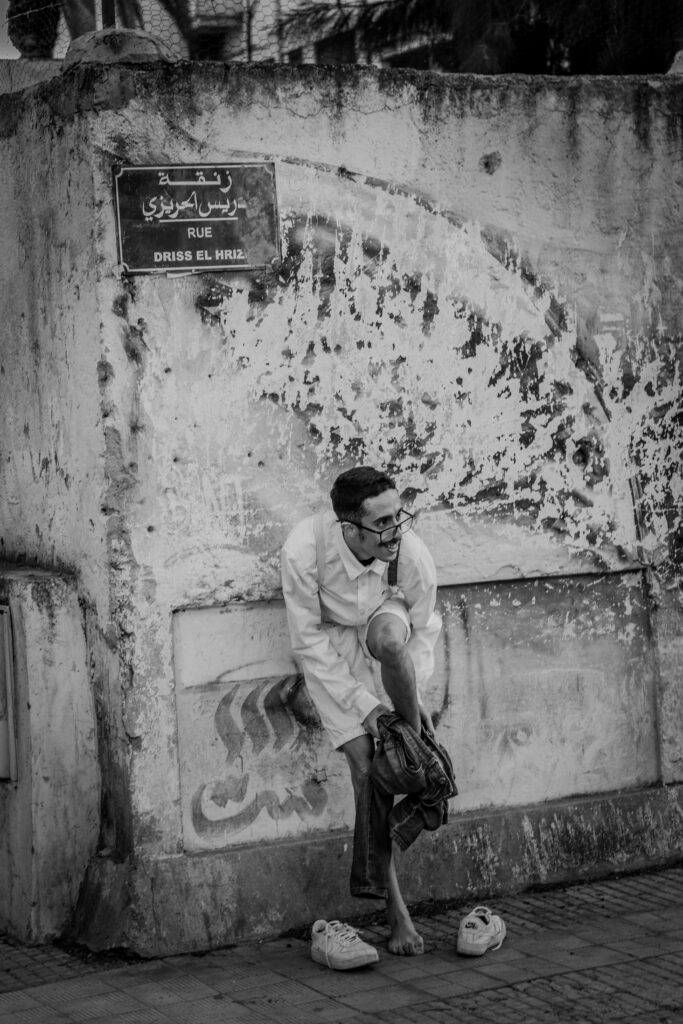How anxiety, memory, and the soul of Fez shaped a filmmaker’s voice
“I didn’t grow up dreaming of becoming a filmmaker,” writes Yassine Benmoussa, artist and storyteller from Fez. “I grew up trying to understand my own silence.”
That single line says everything. There was no grand career ambition, no cinematic fantasy. There was, instead, a quiet war with emotion — a private landscape shaped by anxiety, by unspoken panic, by the confusion of simply existing.
And into that interior world, a camera entered — not as a calling, but as a rescue. “It gave shape to what I couldn’t name,” Yassine tells us. “It became my way of breathing.”
This is the origin of Lost Faces of Fez — a body of work that isn’t simply about photography or storytelling. It’s about survival. It’s about building meaning out of disorder.
The project began as a way of looking outward when the inner world felt too heavy. Through the winding alleys of the old medina, Yassine found faces. Unknown people. Forgotten rhythms. Echoes. But these weren’t subjects — they were mirrors.
“Each face I captured was a silent companion in the chaos of being,” he says.
His portraits aren’t perfectly lit or heavily staged. They breathe. They flicker. They watch you back. “Anxiety teaches you to notice what others don’t,” Yassine writes.
“The tension in a hand. The shadow in a smile.The way someone looks away just before breaking.”
That sensitivity became his visual language. In a world that scrolls past noise and perfection, his work lingers in the raw space between presence and collapse — between a moment being lived and a memory already dissolving.
“I’m drawn to what disappears,” he confesses. “I believe art isn’t meant to explain, but to carry. To hold the weight, the beauty, and the contradictions of life.”
Fez as metaphor, Fez as mirror
To Yassine, Fez is more than home — it’s metaphor. A place dense with memory, saturated in contradictions. “Noise and stillness, history and ghosts.” It’s a city that remembers and forgets at the same time.

And in its ancient veins, he walked to find quiet. To find fragments of himself in the expressions of others. The faces in this project are not named. That’s the point. They are everyone. They are us.
He captures not just identity, but the weight of being seen. The project, in its silence, screams.

This bravery lives in the softness of his frames. In the way light touches a tired face. In the way an alley becomes a sanctuary. The imperfections in his work are not flaws — they’re entry points. Invitations to pause. To feel what we usually avoid.
He does not seek polish. He seeks truth.
Art as translation
What Yassine has created through Lost Faces of Fez is more than visual. It’s emotional translation — the kind that turns panic into poetry, and fear into form. “Even anxiety,” he says, “can be translated, if we’re brave enough to feel.”

Yassine ends his note to us with humility: “This project saved me in many ways. I hope readers will connect with the emotion behind it.”
But what he’s created is not just personal. It’s deeply universal. It’s a reminder that even in disorder, something can be made. That even when we lose our words, we are not lost.
Lost Faces of Fez is not just a photo series. It’s a quiet act of defiance. A beautiful, brave attempt to be present.
And in today’s world — that may be the most radical thing of all.

Check Out More Icons Around The World

